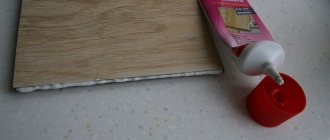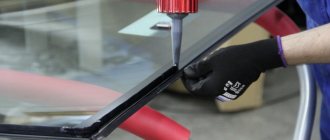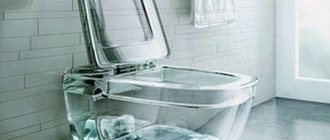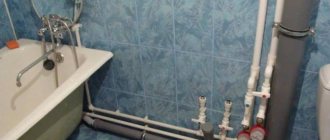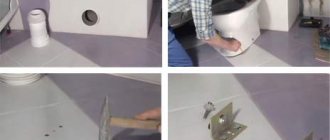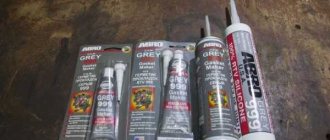Active use of bathrooms leads to the formation of a special microclimate in these rooms. High humidity and constant temperature fluctuations contribute to the accumulation of condensation on surfaces, followed by the appearance of fungus and mold.
Especially often, fungal colonies grow in places that are difficult to reach for cleaning: tile seams, cracks, joints between plumbing fixtures and tiles. Special sealants can prevent destructive processes.
Previously, cement mortars were used to grout joints and plug cracks. However, practice has shown their fragility in conditions of high humidity, temperature and the presence of various kinds of microorganisms.
In modern construction, sealants are used for various external and internal works.
Description and properties of toilet sealant
The sealant must be absolutely waterproof
Operating conditions in the bathroom and toilet are not the easiest. Quite high humidity causes condensation at joints and crevices. It accumulates dust and dirt, creating conditions in the joints that are favorable for the active proliferation of bacteria, fungi and mold. Since the temperature in these rooms is either high or low, moisture accumulates in the joints especially quickly.
Another feature is the likelihood of leakage . Even the most correct installation requires sealing the seams and ensuring waterproofing of all joints. Previously, seals were used for this. However, such materials quickly become unusable. Sealants - acrylic, silicone - last much longer and do not leak.
The sealant is required to be attractive . Black or gray lining of joints is not the best option in apartments where all rooms are decorated stylishly and tastefully.
There is no special sealant for plumbing. However, there are a number of compositions with optimal properties for use in such conditions.
Source
Toilet plumbing equipment
The main elements of a bathroom include a toilet, a bidet, and a washbasin. In this case, the toilet is always used.
The stability and service life of this device depend on the method of fastening and sealing.
Classification of toilets
Devices are distinguished by many parameters:
- Type of bowl. Mostly funnel-shaped or visor-shaped structures, less often - disc-shaped.
- The method of connection to the sewer is direct, inclined or vertical.
Drain - straight or circular.
- Material of manufacture. The main material for budget options is sanitaryware. Porcelain, steel, glass and plastic are also used.
- How the tank is attached - separately, compactly, or located in one housing.
- Mounting methods: to the floor or to the wall.
Sealing places
To prevent leaks, eliminate the accumulation of debris and the appearance of mold, all junctions of the elements are sealed. Pay attention to the spacers between the toilet outlet and the entrance to the sewer.
They are sealed both from the side of the body and from the entrance to the waste pipe. It is recommended to use the same sealant for all seals.
Toilet sealant - installation, types and applications
Toilet sealant - installation, types and applications
In the toilet and bathroom, where the level of humidity constantly increases, fungal colonies and mold often appear on the floor surface. To reduce the risk of the latter, you should use sealant for the bathtub and toilet. A product such as toilet sealant reliably seals all holes and joints, protects the floor from leaks and the formation of pathogenic microscopic organisms.
Depending on the properties and composition, all sealants can be divided into several types, although there are also gels and combined pastes.
Acrylic. Typically, such products are marked with the presence or absence of resistance to water. If the adhesive-sealant does not have the ability to withstand moisture, it can only be used in dry rooms. Waterproof acrylic sealants can withstand high air humidity, but usually do not tolerate constant contact with water. The advantages of the compositions include safety for human health, excellent adhesion, and a large selection of shades. It is recommended to use them for repair work on furniture, doors, windows, but cannot be used in the bathroom.
Manufacturers
Among the most popular companies producing sealants, it is worth highlighting four main ones.
- Ceresit. German products with European quality, standards and practicality. The sealants of this brand are known for their best adhesion to the surface being treated, excellent waterproofing properties and the presence of special additives that protect the room from mold and germs.
- "Moment". The brand, founded by a German chemical company in Russia, has a large number of necessary construction assistants. Among them is the very popular “Moment-Germent”. A large number of varieties of sealants from this company allows any craftsman to choose his own product. Unique products include frost-resistant, high-temperature and restoration options.
- Ciki Fix. The Turkish manufacturer is also among the top four leaders in the Russian construction market. A characteristic feature of this company’s sealants is its extraordinary ability to bond surfaces of different textures together. The seams are waterproof and elastic, but do not protect against fungus and mold.
- Makroflex. Another high-quality brand comes from Germany, but with Russian production. This is a modern and timely solution to any construction and finishing tasks. The company produces a variety of sealants that cope with both internal and external use.
When choosing a plumbing sealant from this variety, the main thing is not to forget its true purpose. And we must use this construction miracle correctly with maximum efficiency.
Types of sealant
Silicone
These are the best products for tiles, toilets, bathtubs, sinks, and various surfaces in the kitchen, and they are in great demand among various craftsmen. Silicone types of pastes have the highest resistance to moisture and temperature changes; they can be used for interior and exterior work.
Polyurethane
They can be adhesive elastic compounds with polyurethane, which is durable, strong and resistant to wear (many types of liquid nails are made from it). Such compositions are suitable for installing and strengthening the toilet tank, as well as sealing it at the base. But such compositions have a huge drawback - toxicity, and therefore are often recommended for outdoor work.
Bituminous
Such sealants are mainly used for outdoor work. They are excellent for installation and repair work on roofing materials, fastening tile particles, sealing brickwork, gutters, foundations, chimneys and ventilation. Bituminous products do not react to ultraviolet rays, they even fill huge voids, but they also contain solvents, and therefore they are very toxic.
Advice from the experts
Experts advise placing the toilet (if possible) at a minimum distance from the sewer pipe, since in this case the corrugation stretches less and, therefore, sag less. A stretched pipe becomes deformed, deposits accumulate on its walls, which pull it down - this leads to potential blockages. There are times when it is impossible to dismantle a sanitary fixture. In this case, you can simply cut off the old plastic pipe with a knife and replace it with a new one.
Some disadvantages of a corrugated toilet pipe should be noted: it is easy to damage from the outside and inside. In the first case, this can happen from any mechanical impact, and in the second, from a sharp object, such as a piece of glass, being flushed down the toilet. Despite the fact that plastic is considered resistant to aggressive environments, exposure to various chemicals that are part of cleaning products still destroys it over time. From an aesthetic point of view, the corrugation does not look very nice, because unpleasant deposits inside are visible through its walls.
Details
Features of silicone type sealants
Sour or vinegar
Such products can be classified as “economy” sealants - they are accessible, quite cheap and reliable. Among the disadvantages, we highlight the sour aroma, which indicates the presence of acid in the composition, and therefore sealants cannot be used on the surface of aluminum or marble due to the risk of damage.
Neutral
To seal the toilet with a sealant, you should use a product. Such compositions are based on alcohol components, as well as metal oxides, which make them much stronger. They are suitable for any type of material, do not cause damage, but are much more expensive than others.
Sanitary
Sanitary products include a group of silicone sealants that are used in residential areas. They do not contain toxic components, and they have a minimal shrinkage percentage, and therefore the seams will remain tight and durable for a long time. Due to the fact that the product is elastic, it is useful for moving units and joints. Often, plumbing-type devices are installed on them, including a toilet, a substrate is installed, and the joints are sealed.
Please note that, among other things, sealant can be used to fill the seams between tiles where they are exposed to water, close the joints between structures and walls, fix small glass items without bolts, and additionally attach mirrors.
steel entrance doors company business bargaining
Advantages of silicone sanitary sealant
A huge advantage of silicone-based sealant is the ease of working with it and the ability to install plumbing fixtures yourself. The product is universal, suitable for a huge range of actions in the kitchen, bathroom, bathhouse, sauna and swimming pool. Other advantages:
How to choose the right product?
Right choice
Silicone sealants are available for sale in various packages - tubes, cartridges and sprays. The cheapest ones are the usual formulations in tubes, which have elongated spouts. Cartridge sealants require the additional purchase of a special gun. They are usually purchased for processing huge rooms.
Please note that silicone sealant must not only be used correctly, but also purchased with a serious approach to the issues. To begin with, you should choose a composition that is suitable in shade, although usually masters prefer white or transparent products. There are still some factors to consider.
Best before date
Sometimes silicone toilet sealant with an expiring shelf life is sold at a huge discount. You should not be fooled by tempting offers - usually the products are very thick, have less elasticity and tend to partially lose other useful characteristics, and even more so fungicidal.
Undamaged packaging
If there is even a very small crack on the sealant body, it will quickly dry out from contact with air. When purchasing, you need to make sure that the integrity of the tube or other packaging is completely preserved. After uncorking, you should cover all the necessary places literally 3-4 days in advance, since otherwise the sealant will begin to dry out.
Manufacturer
Proven and reliable brands produce high quality products. Products such as “Titan”, “Moment”, and “Knauf” have proven themselves best. The disadvantage will be the higher cost, because a popular brand always has an inflated price for the product.
Place of purchase
Sealants are sold everywhere, even in supermarkets. You should not buy them at the market from hand; for this there are special departments at the market or construction/hardware stores, where the goods are definitely not expired.
Application when installing a toilet
To install a toilet with sealant, you need to perform the entire sequence of actions correctly. First, buy all the most necessary materials, prepare consumables and equipment:
Now the preparatory stage.
Preparatory stage
Most often, toilets with an oblique, vertical or even horizontal outlet are installed on laid tiles. For this reason, you will need to carry out the work carefully so as not to damage or break the tiles. To choose the correct position for the plumbing, you should connect the corrugation to the drain in advance. Before installation you need:
Let's consider the next stage.
Marking
To glue the toilet with sealant, you need to mark the entry areas of the anchors on the floor with a marker that can be easily erased from the tile, and then trace the outline of the toilet. Next, remove it and cover the areas around the contour with construction tape. This will make it possible to keep the surface clean.
Hole preparation
The door requires making holes in the floor where bolts will need to be placed. It is important to turn off the impact mode of the drill in advance so that cracks do not form on the surface of the tile. Such a drill will not work for a concrete floor, and you will need to buy a Pobedite one. After the holes are ready, clean them from dust using a vacuum cleaner or dry rag.
Application of the product
Pour a little product inside the holes so that the anchors hold much stronger. The sealant will also serve as waterproofing, and water will not get into the holes. The order of work is as follows:
Please note that if cracks have formed on the toilet legs, they can also be sealed with sealant. Cover up the entire flaw or break from below, completely hiding it and extending slightly beyond the edges. You need to level the product with a spatula, and then immediately wash the tool in a soapy solution, otherwise the product will stick tightly. Using the same soap solution, treat the crack over the applied product and level it with your fingers until smooth, if there is no spatula available.
Application of sealant in old sanitary units
Silicone paste can be used for partial repairs of an old toilet, the joint of which with the floor surface has already lost its strength. To do this you need to proceed as follows:
It happens that the cuff on the toilet, which is placed on the sewer pipe, has lost its seal. It can also be replaced using sealant. To do this, remove the adapter with the cuff from the rubber pipe seal, and also remove the latter, clean and dry. Buy new elements 0 cuff, seal and adapter. Apply silicone sealant to the pipe, insert the rubber band, then lubricate the cuff with a similar compound and secure it in place.
Recommendations for application
In order for the seam to last for a long time, you must follow the rules when working with toilet sealant:
Following the advice and algorithm of actions helps to do the work efficiently yourself without the involvement of specialists and unnecessary expenses.
Source
Preparatory work
To install a toilet on a tile base using sealant and then connect it to various communications, the following materials and tools are required:
- toilet;
- pipe (preferably corrugated);
- ball valve;
- cold water supply hose;
- sealant (any kind, as long as it is waterproof);
- sealant for connections;
- drill for glass and concrete;
- hammer drill (you can also use an impact drill);
- a set of open-end and adjustable wrenches;
- screwdrivers;
- core;
- hammer;
- pencil.
Depending on the type and characteristics of the toilet base, its installation on a tile base can be carried out using two methods: open and closed. The first type involves the protrusion of the bolts that secure this type of plumbing. The second, as is already clear, is their hidden location inside the toilet body itself. But let's take things in order.
Types of silicone sealants
Liquid silicone rubber is a substance used in construction work to protect against the various effects of seams, cracks and joints .
a mountain river, compressed on both sides by an impregnable wall of forest, foamed, raising its shafts and rapidly
Photo 1: Silicone sealants come in tubes and usually look like a thick gel. Resistant to temperature changes or high humidity.
There are several types of sealants:
Acetic or sour
Acetic (acidic) sealants are one-component substances that contain: silicone rubber, enhancer, adhesion primer, silicone plasticizer and vulcanizer, as well as acetic acid.
Such sealing substances have better adhesion and low cost . But they cannot be applied to materials that can react with acetic acid, as they will be destroyed (marble, aluminum, cement concrete, materials that react with acetic acid).
Another disadvantage of these products is the presence of a sour odor .
Neutral
Acidic and neutral sealants are similar in composition , differing only in the presence of acetic acid in the former. Like other building materials, they have certain advantages and disadvantages.
Benefits include:
One of the disadvantages is the problem with coloring the colorless sealant. In addition, the product should not be applied to wet surfaces .
Important! Neutral sealants are suitable for various materials .
Sanitary
A separate group includes sanitary sealants, which are ideal for treating seams in living rooms . They differ from neutral and acetic ones by the presence of a fungicide that protects surfaces from the formation of fungus . These substances are suitable for processing a variety of materials.
The advantages of this type of product include:
Despite many advantages, sanitary sealants have certain disadvantages:
Fixation with dowels
Quite a high-quality fixation option. Dowels secure plumbing fixtures without unwanted backlash and gaps. Before installation, you need to acquire two types of drills.
First, the worker uses a drill of a smaller diameter on the concrete. A prerequisite is to work strictly at high speeds. It would be a good idea to additionally wet the drill and tile with water for cooling.
Then comes the time to use a drill of a larger diameter, corresponding to the size of the mounting holes of the plumbing product. Hole measurements must be made strictly with a caliper, since accuracy is important. After completing all the above steps, the toilet is fixed with dowels.
How to choose a good sealant for installing and repairing a toilet
Bathrooms and toilet rooms are characterized by high humidity. As a result, this leads to the development of mold and mildew.
To prevent the appearance of unwanted microorganisms, special sealants should be used for toilets and bathtubs.
Such products effectively close all holes and joints, thereby protecting the floor from water penetration and preventing the proliferation of harmful microscopic organisms. Classification of sealing agents.
Based on their composition and properties, sealants for toilet installation are classified into several groups:
These compounds are not affected by ultraviolet radiation; they are capable of filling even large voids. But a very big disadvantage is also the toxicity of the product, since they contain solvents.
Distinctive features of silicone sealants for toilet bowls. In order to attach the bathroom to the floor and seal its base, it is recommended to use a silicone agent.
This is a composition with one component that will cope with all imperfections, seams, cracks and tears.
Silicone products, in turn, are classified into several groups.
Advantages of sanitary silicone sealant. The great advantage of the composition is the convenience and ease of its use. You can do the installation yourself.
Such sealants are considered universal, suitable for working in rooms with constant humidity and with materials that have direct contact with water.
What other advantages does this product have? This is the stability of properties when exposed to ultraviolet rays, light, temperature changes, high and low temperatures and humidity.
This composition is suitable for all plumbing surfaces (whether cast iron, acrylic, or other materials).
In addition, as already noted, sanitary toilet sealant can withstand direct contact with water.
Let us list the main advantages of this product: antifungal component (preventing the development of mold and fungi); high strength; high adhesive properties with the substrate; beautiful smooth seam after drying; beautiful appearance; elasticity; high degree of compression and tension with the surface; resistance to chemicals; complete harmlessness to the human body; environmentally friendly.
How to choose the right sealant? Silicone compounds are produced in various forms (in the form of a spray, tube, cartridge). The cheapest option is a tube that has a special long tip.
This option is suitable for working on large areas. To get a good result, you need to choose the right sealant and use it properly.
What should you pay attention to when purchasing a sealant for toilet installation? Firstly, the choice of color. Many people choose white or colorless (transparent) sealant. Let us note additional important aspects regarding the acquisition of material.
Using sealant when installing a toilet. To install a bathroom using sealant, you must follow the steps. Firstly, you need to immediately take care of purchasing all the necessary tools and consumables.
Next is preparation. Most toilets are installed on pre-fabricated tiles, so you should be very careful when working so as not to damage the tiles.
You need to choose a position for the bathroom, after connecting the corrugation to the drain.
Before installation, do not forget to turn off the water, wash the nearby work area, rinse the bottom of the toilet and degrease the attachment area. Next is marking the space on the floor.
It is necessary to mark the entry points of the anchors with a tile writing agent (marker), which can be easily wiped off the floor, and mark the contours of the toilet bowl. It is recommended to treat the areas around the future toilet with construction tape to ensure a clean job.
The next step is preparing the holes. Use a drill to form the floor holes where the bolts will go. To avoid cracks on the tiles, do not forget to turn off the impact mode of the drill.
This type of drill is not used for concrete floors; it is recommended to purchase a Pobedite drill.
Next comes the step of applying toilet sealant. It is necessary to put a small amount of sealant in the hole so that the anchors stay in them better. In addition, the product will act as a water insulator, meaning water will not penetrate into the holes.
interior doors sliding into the wall on rails
Let us list the next stages of work: spread a good layer of sealant along the contour; place the toilet and press down very tightly; fix with anchors, place a rubber gasket under the head of the fastener; remove any remaining sealant; remove construction tape.
If a crack appears on the toilet, you can also treat the defect with a sealant. Seal the entire crack from below completely and beyond its limits. Next, level the sealant with a spatula. It must be remembered that the spatula must be washed immediately with a mat, otherwise the sealant will be impossible to remove.
Using the same soapy liquid, clean the defect over the composition and level it until the surface is smooth.
Using sealant when repairing an old toilet.
The sealant can be used not only to install a new bathroom, but also to repair an old one, if, for example, the place where it connects to the floor has lost its complete seal. To do this, you should do the following: work with the base (remove dust, dirt, previous sealant); degreasing the surface; using a special gun, apply sealant directly into the seam without interrupting the line.
Next, remove the remaining product with a rag, and after a couple of minutes begin leveling the sealant to the level of the plane. You can use a spatula or make the seam with your hands (wearing gloves).
After this, you need to wait until the product hardens and cut out the excess with a knife, thereby forming a beautiful, even seam. If the toilet cuff (which is in contact with the sewer pipe) has lost its tightness, it can be changed using a silicone seal.
What should be done? Remove the cuff from the pipe (with adapter) and the pipe seal from the rubber. Purchase the same, but new components. Lubricate the pipe with a sealing compound, insert a rubber band, apply silicone to the cuff and also install it in place.
Tips for using silicone sealant. Important recommendations for the use of sealant - sealant: the maximum width and thickness of the seam are 30 cm and 1 cm, respectively; maximum application depth – 6 cm; for significant imperfections in depth, use plumbing tape.
Following these tips will allow the seam to last longer. Knowing the rules for working with the composition, you will be able to complete the work not only efficiently, but also independently, without resorting to additional help, thereby saving your budget.
Source
Epoxy adhesive
The easiest way is to purchase this substance in a store or order it online. You can also make epoxy glue at home, but to do this you need to maintain the proportions of the ingredients. To make it, the following components are mixed:
- epoxy resin (10 parts);
- cement (20 parts);
- solvent (2 parts);
- hardener (3.5 parts).
Epoxy glue
After preparing all the necessary components, you need to heat the epoxy resin to a temperature of 50 degrees. Next, a solvent is mixed into it. The next step is to add a hardener. Cement is added last.
Important! The resulting composition must be mixed very thoroughly. You can use the finished glue within 2 hours.
Epoxy glue has many benefits. But the most important thing is that it ensures high strength of the finished connection. Such a seam will last reliably for many years. The ability to prepare this composition with your own hands is also a big plus.
Interesting: 6 ways to disguise pipes in the bathroom
Types of sealants
When planning a bathroom renovation, choosing a composition, you need to know which sealant is best suited for working with plumbing fixtures.
Silicone
Popular sealing agents. Used for repair work. They are well suited for use in bathrooms and kitchens. They have increased resistance to moisture and can easily withstand sudden changes in air temperature. Silicone sealant is a material for installing toilets and waterproofing.
Acrylic
There are waterproof and non-waterproof compounds. Both types are safe to use, have a choice of colors and adhesion. Despite their positive qualities, they are preferable to use for working with wooden surfaces (doors, frames, jambs, furniture).
Polyurethane
Polyurethane-based compounds are durable, wear-resistant and elastic materials. Due to toxicity, they are not recommended for interior use.
Bituminous
Sealing agent based on bitumen. Such compositions are adhesive to dry, wet roofing materials (tiles, bricks, wood, aluminum and steel). They are UV resistant. They are used for filling roof seams, voids, gluing bitumen shingles, sealing gutters, chimneys, and ventilation ducts.
When choosing a sealant for the bathroom, take into account the characteristics of the material from which the plumbing fixtures are made.
What does it contain?
The production of silicone sanitary sealant is based on silicon (it is from it that silicone polymer material is obtained). Sealing compounds made from silicone also include various additives:
- Manufacturers must add a fungicide to the product. It is necessary to provide a bactericidal effect and prevent the occurrence of mold lesions.
- To reduce the viscosity of the mixture, organic extenders are used.
- Mechanical fillers (manufacturers usually use glass or quartz dust, chalk and other suitable components) can improve the quality of the connection with different surfaces.
Important! To obtain a sealing mixture of a certain shade, dyes (colors) are used. They are added immediately at the factory, because silicone sanitary sealants, taking into account the instructions for use, as well as the specifics of use and operation, cannot be painted after application.
Silicone sealants
Silicone rubber compounds are suitable for plumbing installation and waterproofing. Silicone is different from other materials used to make sealants. Hardening of the mass occurs due to the absorption of water from the air.
Advantages
Transparent and white silicone compounds are sold in stores. You can add dye to colorless ones.
Varieties
There are two categories of silicone sealants:
The first products include acidic and neutral silicone compounds.
Acidic cleaners are an inexpensive product that produces a strong vinegar smell when working with it. It is not recommended for use on materials that react with acid (metals, marble, concrete).
Neutral substances contain alcohol or oxide impurities that do not smell.
Conditional division of sealants according to purpose of use:
Of these types, a sealant marked “Sanitary” is an excellent option for plumbing work. It can be used to install a toilet without bolts.
Two-component products include silicone sealants used in industrial production. Hardening occurs when the base is mixed with the catalyst. This is a durable and wear-resistant material.
Additional operating recommendations
- Sealing tape must be used to fill gaps and cracks.
- The width of the seam should not exceed 30 mm, and the depth should not exceed 1.5-2 times the width.
- When working with a toxic species, safety rules are observed (hands, eyes, respiratory tract are protected, the room is thoroughly ventilated).
- After drying, a second layer cannot be applied to the same place.
The distribution of silicone sealant along the seams is done using a special construction gun.
When purchasing sealant, you need to pay attention to the expiration date and type of tube. The presence of cracks causes the product inside the package to harden.
The purpose of sealing system elements
The sewerage system is reliably sealed during the installation stage. During operation, the internal system is regularly inspected in order to detect and eliminate leaks in time.
Wastewater should not flow out, and nothing should get into the sewer system from the outside, because... this can disrupt its operation and lead to serious damage.
Particular attention should be paid to sealing pipes laid underground, as they are much more difficult to repair if leaks occur. If the operation of the system is disrupted due to groundwater entering it, a lot of effort will have to be made to determine this.
Repairing the underground part of the sewer system is almost as labor-intensive and expensive as installing a new section of pipeline. It involves a large volume of excavation work, replacement of damaged system elements
Careful sealing during the construction phase of the sewer system prevents a number of problems:
- Leaks to the outside. Once in the soil, wastewater can contaminate water in drinking wells and cause serious illnesses. The unpleasant smell of sewage in premises is also dangerous, because... rotting organic matter releases gases harmful to humans: hydrogen sulfide, ammonia, methane.
- Flooding of buildings and structures. In case of severe leaks, soil erosion may occur. Sewage water floods foundations, cellars, cellars, and basement floors. Due to the high content of chemically active substances, they accelerate the destruction of building materials and provoke corrosion.
- Leaks into the system. If atmospheric or groundwater enters the system, the pressure in the pipeline increases. Due to the strong pressure of wastewater, the operation of pipes is disrupted, and treatment or storage facilities may not be able to cope with the additional load and fail.
- Leaks at joints due to temperature changes. If the system is initially installed efficiently, the joints are reliable and do not leak even without additional sealing. However, processing is still necessary, because Temperature changes over time lead to a decrease in tightness.
Various types of pipes are used to install sewerage systems. A suitable sealant should be selected for each pipe material. The choice also depends on the installation technology and the intended purpose of each individual element of the system.
Water supply
A common problem with the appearance of puddles near the toilet is the depressurization of the connection between the water pipe and the tank fitting. In modern models, plastic components are found. Therefore, during operation, the threads can wear off and thus the seal is destroyed.
This problem can be resolved very simply. Shut off the water supply with a shut-off valve. The hose is twisted and flax or fumlent is wound onto the thread. Screw it back. If the leak stops, the problem is resolved. If not, then you should repeat the procedure, increasing the layer of sealing material. Another reason could be a crack in the plastic fitting. In this case, it should be replaced with a new one.

